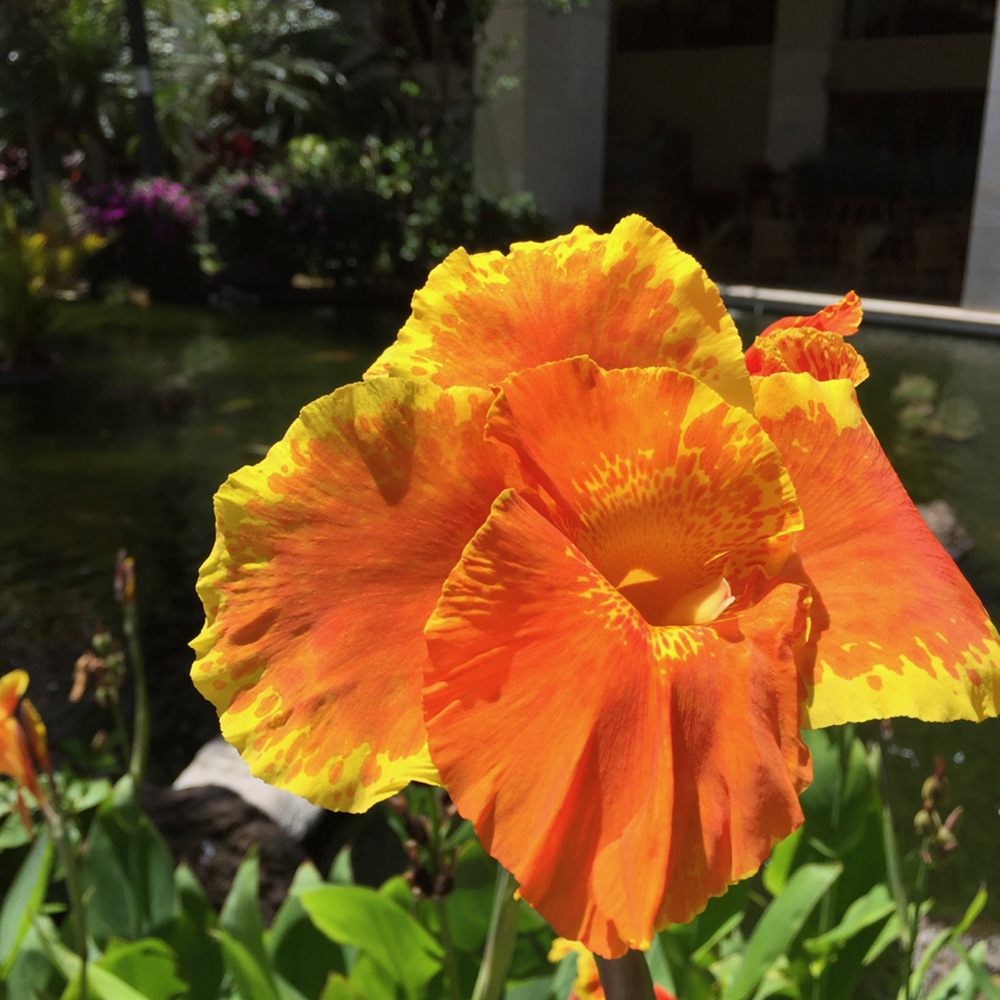
If you would enjoy a garden full of flamboyant blooms with a tropical look, canna lilies might be an excellent choice for you. These perennial flowers are available in a variety of different colors, and they sport large paddle-shaped leaves. The plant itself is lovely, and would make a terrific addition to your landscaping even if they never bloomed! Fortunately for all of us, canna lilies do indeed bloom, all the way from late spring to early frost in most cases.
How to plant canna lilies from tubers. Some gardeners do grow canna lilies from seed, but this is often a difficult process. Unless you’re an expert, we advise purchasing and planting the tubers or bucketed plants for more consistent results.
Canna lilies require a lot of sunshine, so choose a sunny spot in your garden. Loosen your soil to about a foot in depth, and mix in compost. Then dig holes about two to three inches deep, spaced one to four feet apart, and place your rhizomes in the holes. Yes, they really do need to be placed that far apart from one another, as rhizomes send out lateral shoots and spread quite prolifically underground.
Now, water thoroughly, and keep in mind that canna lilies require moist soil. Since our climate is quite dry here in Southern California, check your plants regularly and water them freely. Mulching underneath them will help to retain moisture as well.
How to care for canna. To keep your canna lilies blooming throughout the season, remove dead flowers promptly. This will promote continuous flowering so that you can enjoy your lilies all summer. Once autumn arrives and your canna lilies stop blooming, you will notice the foliage blackening. At this point, you can cut each stem to the ground.
Cannas spread underground by sending out lateral shoots. Over time, your plants can become congested. Every three to four years, dig up the root clumps, carefully separate them, and replant them spaced at least a foot apart.
A few things to remember. Canna lilies are relatively hardy in our climate. However, they can be prone to problems like leaf rot, bacterial blight, and rust. Slugs, snails, caterpillars, and spider mites also enjoy munching on canna lilies. Monitor your plants carefully for signs of these problems, and contact us if you have any concerns. When treated early and correctly, these health problems can be corrected.
If you would enjoy a garden full of flamboyant blooms with a tropical look, canna lilies might be an excellent choice for you. These perennial flowers are available in a variety of different colors, and they sport large paddle-shaped leaves. The plant itself is lovely, and would make a terrific addition to your landscaping even if they never bloomed! Fortunately for all of us, canna lilies do indeed bloom, all the way from late spring to early frost in most cases.
How to plant canna lilies from tubers. Some gardeners do grow canna lilies from seed, but this is often a difficult process. Unless you’re an expert, we advise purchasing and planting the tubers or bucketed plants for more consistent results.
Canna lilies require a lot of sunshine, so choose a sunny spot in your garden. Loosen your soil to about a foot in depth, and mix in compost. Then dig holes about two to three inches deep, spaced one to four feet apart, and place your rhizomes in the holes. Yes, they really do need to be placed that far apart from one another, as rhizomes send out lateral shoots and spread quite prolifically underground.
Now, water thoroughly, and keep in mind that canna lilies require moist soil. Since our climate is quite dry here in Southern California, check your plants regularly and water them freely. Mulching underneath them will help to retain moisture as well.
How to care for canna. To keep your canna lilies blooming throughout the season, remove dead flowers promptly. This will promote continuous flowering so that you can enjoy your lilies all summer. Once autumn arrives and your canna lilies stop blooming, you will notice the foliage blackening. At this point, you can cut each stem to the ground.
Cannas spread underground by sending out lateral shoots. Over time, your plants can become congested. Every three to four years, dig up the root clumps, carefully separate them, and replant them spaced at least a foot apart.
A few things to remember. Canna lilies are relatively hardy in our climate. However, they can be prone to problems like leaf rot, bacterial blight, and rust. Slugs, snails, caterpillars, and spider mites also enjoy munching on canna lilies. Monitor your plants carefully for signs of these problems, and contact us if you have any concerns. When treated early and correctly, these health problems can be corrected.









Write a comment: